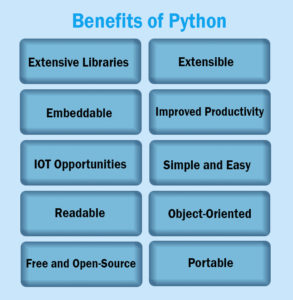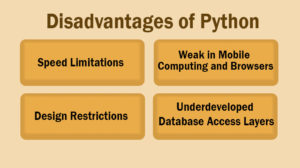Pros and Cons of Python in Machine Learning
Category: Machine Learning with Python Posted:Nov 28, 2018 By: Robert
The technological world is growing continuously with amazing speed. Most of the businesses are implementing Machine Learning algorithms in order to optimize their products. With the help of Machine Learning algorithms, companies are capable of increasing their top-line growth and enhancing processes which in turn increases the workforce engagement and customer satisfaction. Using Machine Learning, businesses can re-imagine end-to-end business processes including digital intelligence. There is a broad prospective of machine learning which makes the software vendors investing heavily to include Machine Learning algorithms in their current applications as well as in developing new solutions.
We know that Machine Learning is one of the fastest evolving fields, it involves different algorithms which the businesses can utilize for developing their projects. These algorithms can be implemented using different programming languages. But, sometimes developers may face challenges in implementing these algorithms and thus requires an easy programming language which helps in developing their project efficiently. Machine learning algorithms are implemented using various languages such as C, C++, JavaScript, R, and Python. But Python programming language has become the choice of every developer nowadays because of its various features. Though Python programming language possesses several characteristics, it has some advantages and disadvantages too. This article focuses on some of the pros and cons of Python Programming Language.
Attend live webinar on Machine Learning with Python
Python Programming Language for Machine Learning: Nowadays, Python programming language is gaining more popularity in Machine Learning projects due to its various features. It is a high-level, general purpose and dynamic programming language which is not new in the market. It is available for almost thirty years. Python programming language can be found practically at everyplace, like web and desktop apps, machine learning, network servers and many more. It is mainly used in small project development, but now the big firms such as Google, Facebook, Microsoft, and Netflix are also utilizing Python in implementing their projects. It is one of the fastest growing programming languages, and it is expected that Python will take over other languages such as JAVA in the upcoming year. Python programming language has several advantages which enable Machine Learning developers to use it for developing their Machine Learning projects.
Pros of Python Programming Language

Let’s have a look at the advantages of Python, which shows that it is the best programming language for Machine Learning:
1. It has an excellent collection of in-built libraries: Python claims a huge number of in-built libraries for data mining, data manipulation, and machine learning. For example, NumPy, this is used for scientific calculation. Scikit-learn have tools for data mining and analysis which optimizes the Python’s brilliant machine learning usability. Panda is another package which provides developers with high-performance structures and data analysis tools and helps them to reduce the project implementation time. Similarly, SciPy is used for advanced computation, and Pybrain is used for machine learning.
2. Moderate learning Curve: Python Programming language is very accessible and easy to learn and use. It focuses on code readability. It is versatile and well-structured language.
3. It is a general-purpose programming language: Well, Python is a good choice if the project requirements are more than just information such as developing a functional website.
4. Easy to integrate: Python programming language incorporates better than “R” in business environments. It is easy to integrate Python with other lower-level languages such as C, C++, or Java. Similarly, the Python based-stack is easy to incorporate with data scientist’s work, which allows it to bring efficiently into production.
5. High productivity: Syntax in Python is extremely readable and easy to understand similar to other programming languages, whereas R programming language has different syntax. The readability syntax in Python programming language confirms high productivity of development teams.
6. Easy to create prototypes: It is already stated that Python is easy to learn and fast to develop. It requires less coding, which means that you can create prototypes and test your concepts quickly and easily in Python as compared to other programming languages. Developing prototypes in Python not only saves developers time, but it also decreases your company’s costs.
7. It is free and open source: Python programming language is available freely; this allows you to download Python for free, i.e. you can download its source code, make the modifications in it and then distribute it. The download comes with an extensive collection of libraries that supports you to carry out your tasks.
8. Object-oriented paradigm: Python programming language supports for both the Object-oriented and procedural programming models. Classes and objects in Object-oriented programming help us to model the real world while functions in procedural programming enable us to reuse the code. A class in Object-oriented programming encapsulates data and function together.
9. Portability: Python programming language is portable, i.e. code written in Python can be run on another platform; this is called Write Once Run Anywhere, i.e., WORA, but this is not possible with other languages like C++. When you have to run C++ code on other platforms, it requires making some modifications in the code to run. It is not advisable to use any system-dependent features.
Cons of Python Programming Language: It is always recommended to use the correct tools for the project implementation. We know that a coin has two sides; similarly, Python programming language not only have benefits but there are some downsides too. We have seen its advantages, so let’s see some of its disadvantages also. There are a few issues which programmers can face while choosing this programming language.

1. Limited speed: We know that Python is interpreted language, i.e., the code in Python is executed line by line. Thus, Python often results in slow execution as compared to other programming languages. The speed is not a problem unless it is a main point for the project. In another way, if high speed is not a requirement, Pythons benefits are sufficient to divert us from its speed limitations.
2. Problems with threading: Python does not support threading because of Global Interpreter Lock, i.e., GIL which is a mutex; this permits only a single thread to execute at a time. The multi-threaded CPU-bound programs can be slower than the single-threaded; this issue can be resolved by implementing multiprocessing programs in place of multi-threaded applications.
3. Not intuitive to mobile environment: Python is not inherent in mobile environment, and it is realized as a weak language for mobile computing. Mobile environment such as Android and iOS does not support for Python as an official programming language. But with some extra efforts, it can be used in mobile purpose as well. Numerous libraries offer a way to develop for both Android and iOS through Python.
4. Design limitations: We know that Python is a dynamically-typed language which means that it does not require declaring the variable type at the time of coding. It practices duck-typing (Duck-typing:-It is a concept which means that the type of object concerns only at run-time and it is not required to mention the type explicitly); it means that if it looks like a duck, it should be a duck. It can raise a run-time error which can be easily seen by programmers during coding.
5. Underdeveloped database access layers: Python’s database access layers are not yet developed as compared to other widely used technologies such as JDBC, i.e. Java Database Connectivity and ODBC, i.e. Open Database Connectivity. Therefore, it is not practical to use it in big enterprises.
Want to know More about Machine Learning with Python? Click here
Conclusion:
Python programming language is one of the top most languages used in implementing Machine Learning projects. It is broadly used all over the industries and allows easy association within development teams. Presently, most of the companies like Google, Facebook or Microsoft are choosing Python, and its various features such as simple, approachable, versatile, and complete make it choice of every developer.




 99999999 (Toll Free)
99999999 (Toll Free)  +91 9999999
+91 9999999